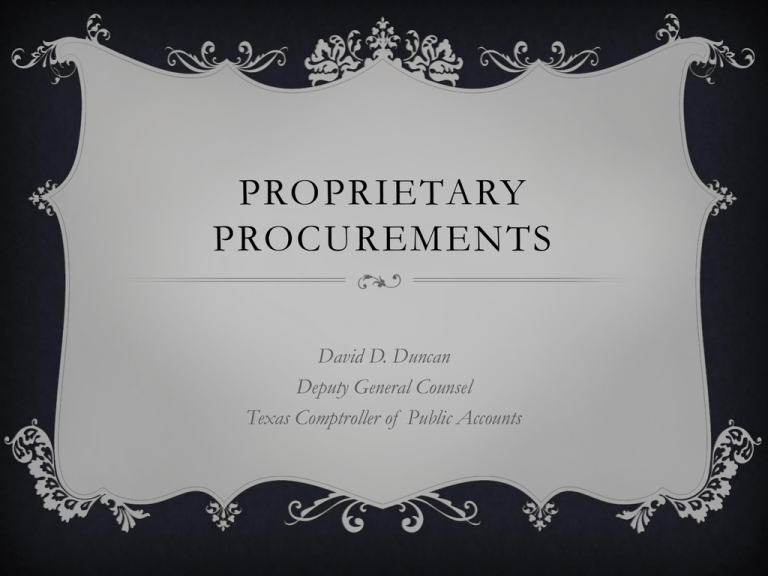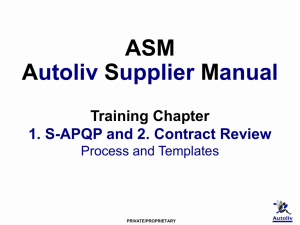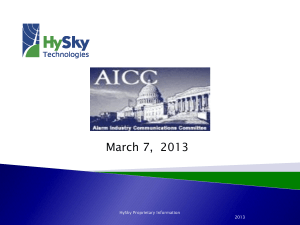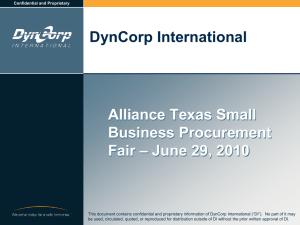Proprietary Procurements - Texas Comptroller of Public Accounts
advertisement

PROPRIETARY PROCUREMENTS David D. Duncan Deputy General Counsel Texas Comptroller of Public Accounts PROPRIETARY What does it mean? Webster’s defines proprietary as “something that is used, produced, or marketed under exclusive legal right of the inventor or maker (e.g., a drug that is protected by secrecy, patent, or copyright against free competition as to name, product, composition, or process of manufacture).” Also defined in TPASS rules (34 TAC §20.32(42)): “Products or services manufactured or offered under exclusive rights of ownership, including rights under patent, copyright, or trade secret law. A product or service is proprietary if it has a distinctive feature or characteristic which is not shared or provided by competing or similar products or services.” PROPRIETARY VERSUS SOLE SOURCE Sole source is where “there is only one person or company that can provide the contractual services needed, so any attempt to obtain bids would only result in that person or company bidding on it.” Proprietary = one maker; Sole Source = one supplier or bidder. It is not only possible, but LIKELY that “proprietary” products can be competitively obtained, therefore proprietary but NOT sole source. Example: specific software. It may be “proprietary” in that your specifications dictate that only one software will do, but it is possible that many suppliers/resellers will bid competitively to sell it to you. BACK TO BASICS First and most important question (really, the only question worth asking) . . . WHAT DOES THE STATUTE SAY? Tex. Gov’t Code §2155.067(a): • If, after review under Section 2155.066, the [comptroller] finds that specifications and conditions of a purchase request describe a product that is proprietary to one vendor and do not permit an equivalent product to be supplied, the [comptroller] shall require the requesting state agency to justify in writing the specifications or conditions. THE CRUX This is the key language in 2155.067: The written justification must: (1) explain the need for the specifications; (2) state the reason competing products are not satisfactory; and (3) provide other information requested by the [comptroller]. MECHANICS The letter justifying the proprietary procurement must be signed by “agency head or the presiding officer of the agency’s governing body.” That signature can be delegated to another person pursuant to an agency’s policies and authority BUT that delegation has to be documented or on file with CPA TPASS. CPA has provided a template of a proprietary letter – it is available to anyone. We have also provided reviews of draft letters to assist agencies. PROPRIETARY PURCHASE JUSTIFICATION Texas Comptroller of Public Accounts Att’n: Texas Procurement and Support Services Division Re: Proprietary Purchase Justification for [insert: commodity code/general item description] I. State what commodity item(s) or services your agency proposes to purchase, and give general background regarding the agency’s need for and planned use of the goods. II. Provide a clear statement why the agency specifications for the product are written as they are, and why those specifications are necessary to accomplish the agency’s goal for the procurement. III. Explain clearly why any competing products do not meet the needs of the agency for the specific commodity. Give examples of the technical, practical, or operational issues that would occur if competing products are selected. Signature – NOTE: statute requires signature by the Executive Head or Presiding Officer of a state agency, or their designee. If anyone other than the ED or Presiding Officer of the agency will sign the submission, the agency shall have the appropriate signed delegation available, and shall provide that delegation letter to CPA-TPASS upon request. OTHER THINGS APPLY! Posting – you must post a solicitation in ESBD for the appropriate period. Why? IN CASE YOU’RE WRONG and some other provider can meet the specification. There’s no exemption from 2155.083 (the ESBD posting requirement) and if you don’t meet the posting time requirements of that section your procurement is VOID (§2155.083(j)). Delegation – Your agency still needs statutory, rule, or a letter of delegation from CPA TPASS to perform the procurement. CAT review – the basis for CAT review is a totally different statute – Gov’t Code Chapter 2262. No exemptions for proprietary in there either. COMMON MISTAKES Not discussing the SPECIFICATIONS like the statute requires. Focusing on the product or service your end users “want” to buy. Failing to discuss alternative products at all. Failing either to have the correct person sign, or to document that the signatory has authority. Relying on the vendor to “prove” that their product is proprietary. Failing to understand the difference between proprietary and sole- source. EXAMPLES FROM THE CRYPT “We are of the opinion that [the vendor’s product] contains a restrictive specification in accordance with 2155.067.” “Our professionals have identified [vendor’s product] as the most durable, safe, and efficient system of its kind.” “These items are essential to continue [the work the federal government is joining us in funding and performing].” “[The vendor] has claimed their technology is proprietary and we agree.” “[Vendor] is the exclusive patent holder of US Patents [X, Y and Z]. No other manufacturer can legally produce [the product] with the same properties.” MORE FUN EXAMPLES “[Our agency] has performed research [on these products]. The manufacturer can provide [a range of products] that will enable [our agency] to [meet our statutory requirement].” “Our staff tested [these products] against others, and only [the identified products] passed our rigorous qualification process were placed on the agency’s approved products list.” We can only buy products on our approved products list, therefore these products are proprietary. This is the only vendor the feds will let us spend this money with. This vendor is our incumbent and only their products will work with the equipment we already have. IN SUMMARY Focus on the specifications – why do they result in a proprietary? Make sure to document the processes that resulted in the specs. Plan ahead to make sure the signatory is the correct person to sign and has authorization. In general, don’t just listen to your end user’s or vendor’s assertions about the “uniqueness” of a product – DO YOUR HOMEWORK. THE END?








